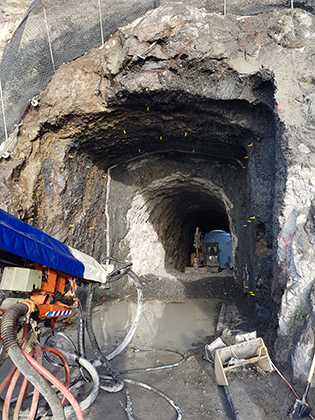
Shotcrete robot entering tunnels at Kaikoura earthquake recovery project.
The Kaikoura earthquake recovery project run by the North Canterbury Transport Infrastructure Recovery (NCTIR) alliance in New Zealand has won the Institution of Civil Engineers (ICE) People’s Choice Award 2018.
The devastating 7.8 magnitude Kaikoura Earthquake of 14 November 2016 caused significant damage to the road and rail corridors along the Kaikoura coast and required an immediate engineering response to rebuild infrastructure. The New Zealand Transport Agency (NZTA) and KiwiRail came together to form the NCTIR alliance with four of New Zealand’s largest contractors and were tasked with the huge job of rebuilding the road and rail corridors.
SCT Operations was engaged by NCTIR to conduct the geotechnical assessment, design, construction supervision and monitoring of four one-way road tunnels totalling approximately 200m in length. The unsupported road tunnels had been initially constructed at least 80 years ago in greywacke rock through narrow headlands adjacent the coast. The tunnels required widening as part of the NCTIR work program to improve clearances for large vehicles and to increase the capacity of the highway. The design requirement called for a 100yr design life of the structural support elements as well as relatively tight construction time frame to support key road re-opening milestones whilst minimising travel delays to the road users.

Pictured Above: Site establishment showing tunnel portals

Pictured Above: Pre-construction shotcrete test panels being sprayed.
SCT's geotechnical investigations comprised mapping and geotechnical drilling inside the tunnels to obtain defect and rock strength information for design. Support design was optimised using both empirical and computer modelling techniques which comprised FLAC2D. The support design option implemented was a two pass macro-synthetic reinforced shotcrete liner (with cast in place concrete lower sidewalls) to provide a total thickness of 250mm. Combination rock bolts (3m long CT-bolt) were also installed where conditions dictated during construction.
Pre-construction shotcrete trials were undertaken to ensure a quality shotcrete product was achieved in the tunnels and to verify that the sprayed concrete would meet the minimum design criteria and specification requirements prior to being placed in the permanent works. The shotcrete trials proved valuable in refining mix design and operational issues prior to construction and confirmed a suitable mix design that offered good placing characteristics and achieved design specification. The trials were also used to determine safe re-entry times under the freshly sprayed shotcrete so that construction timing and costs could be optimised.
The physical works, which fell under recently introduced New Zealand Tunnel Regulations, required the development of a Ground and Strata Instability Management Plans, monitoring plans, TARPs and workforce strata control training modules.
Construction equipment comprised a 30T excavator fitted with an Erkat cutter head, shotcrete robot and bolting Jumbo. The first pass shotcrete liner was used as temporary support and allowed for rapid advancement of the tunnel in comparison to other methods (cast in place concrete liner) considered in the initial design. The construction sequence resulted in minimal travel disruption to road users and rapid tunnel advance rates.

Pictured Above: Chris Lee, Geotechnical Engineer from SCT giving the contractor advice as operations commence.

Pictured Above: Shotcrete robot ready for spraying.
Three of the four tunnels have now been delivered on time and in budget. Given the success of the shotcrete in the road tunnels the technology was used elsewhere on the NCTIR project.
SCT are proud to have worked alongside other NCTIR consultants and contractors on an award-winning project.

Pictured Above: 30 Tonne excavator, excavating tunnel opening.

Pictured Above: Kenny Mills from SCT who worked as a Tunnels Site Engineer celebrating the tunnel opening.
For further information on Civil Works Design please contact Stuart MacGregor or for our New Zealand office Please contact Chris Lee
